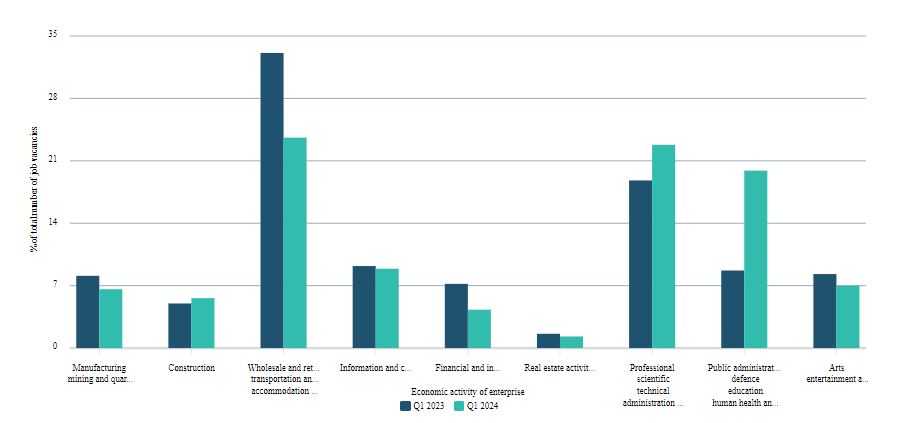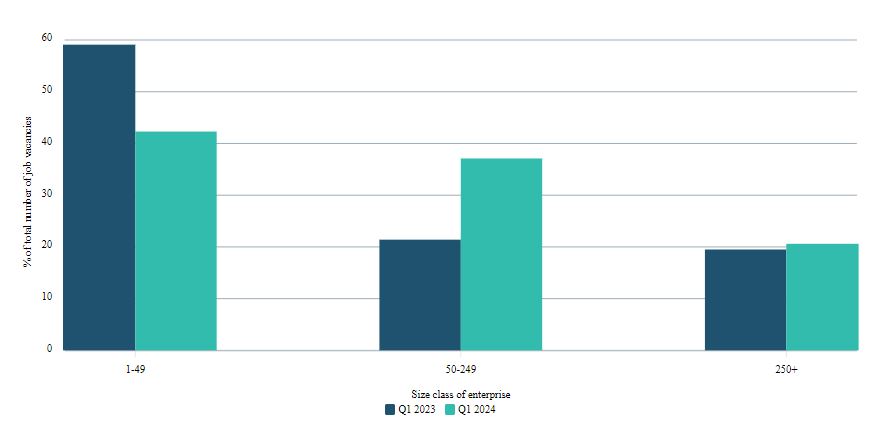There has been a marked increase in the number of job vacancies posted during the first three months of 2024 when compared to the same period of the previous year.
The findings emerge from the Job Vacancy Survey conducted by the National Statistics Office.
It found that in the first quarter of 2024, the number of job vacancies stood at 8,694, an increase of 27.9 per cent over the same period in 2023.
The private sector was responsible for the lion’s share, representing 84.8 per cent of all vacancies. The rest (15.2 per cent) were jobs offered in the public sector.
Over three-quarters (75.2 per cent) of all job vacancies were in a relatively small number of broad sectors.
The wholesale and retail trade, transportation and storage, and accommodation and food service activities sector generated 23.6 per cent of all vacancies during the first quarter of 2024. However, this represents 201 vacancies fewer than a year prior, representing a steep drop of 9.5 percentage points over its share in the first months of 2023.

Professional, scientific, technical, administration and support service activities had the second highest number of vacancies, representing 22.8 per cent of the total, after an increase of 708 vacancies over the previous year.
The sector with the third-largest share of job openings was public administration, defence, education, human health and social work activities. This sector also saw the highest year-on-year increase with an addition of 1,144 vacancies.
The survey results show a correlation between enterprise size and number of job vacancies. In this regard, small enterprises (1 to 49 employees) contributed to approximately four in every ten vacancies whereas companies with 250 employees or more generated 20.6 per cent of all vacancies of the first quarter of 2024.

Job Vacancy Rate
In the first quarter of 2024, 3.2 per cent of jobs in Malta were vacant, increasing by 0.4 percentage points when compared to the preceding quarter and 0.6 percentage points from the first quarter of 2023.
The job vacancy rate was highest within the information and communication sector (6.1 per cent) whilst the manufacturing, mining and quarrying and other industry registered the lowest rate of job vacancies (2.2 per cent).
Medium sized enterprises, with 50 to 249 employees, showed a higher job vacancy rate of 4.5 per cent, suggesting a greater demand for labour in this segment. Large enterprises, comprising 250 or more employees, exhibited a lower rate of job vacancies at 1.7 per cent.
The private sector registered a job vacancy rate of 3.4 per cent in the first quarter of 2024 whereas 2.3 per cent of total jobs in the public sector were vacant during the same period.
Occupied Posts
During the first quarter of 2024, the total number of occupied posts within enterprises employing one or more employees stood at 264,379.
Just over one fourth of these posts were recorded in the wholesale and retail trade, transportation and storage, accommodation and food service activities. In this regard, over a period of one year, this category of economic activities registered a growth of 3.7 per cent.
A further 65,705 occupied posts were estimated to be in the public administration, defence, education, human health and social work activities sector, making up 24.9 per cent of the total number of occupied posts.
During the first quarter of 2024, 38.7 per cent of occupied posts were estimated to be in enterprises employing 250 employees or more. Units with 50 to 249 employees made up just above one fourth of all occupied posts.
Occupied posts within the private sector stood at 209,428, garnering 79.2 per cent of the total amount of jobs. The public sector totalled 54,951, making up the remaining 20.8 per cent.
Two years since its birth, Moneybase features on Microsoft’s Customer Stories
Moneybase has now just been featured on Microsoft’s latest Customer Stories
Finance Minister confirms continuity of food and energy subsidies
Spending on food and energy subsidies as a percentage of the GDP will be at 0.7% in 2025
MHRA congratulates Glenn Micallef on EU role, highlights positive impact on Malta’s tourism and cultural sectors
The lobby group emphasised that Malta’s cultural assets and sports scene are key factors in attracting visitors and fostering economic ...






